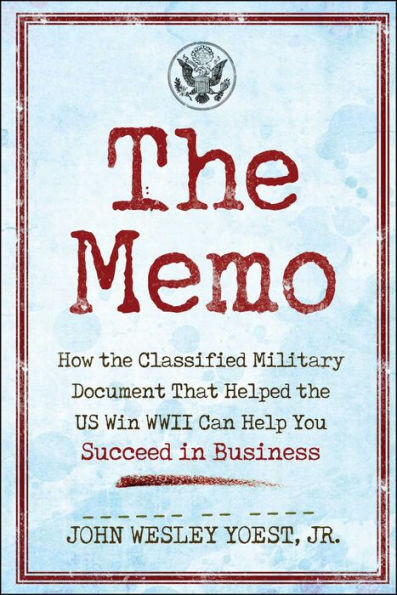The Memo: How the Classified Military Document That Helped the U.S. Win WWII Can Help You Succeed in Business
The Memo reveals how to succeed in business using the covert WWII strategy that ultimately led to the Allied victory.
Much is known about how the atomic bomb helped the United States achieve final victory in World War II. However, little is known about a weapon that was, perhaps, even more powerful—a memo. Classified as “Restricted” by the U.S. War Department, “The Memo” contained a management doctrine under the subject of “Completed Staff Work." This memo turned military command structure on its head and focused on the power of staff instead of their commanders. Simply put, instead of relying on senior leaders to think up solutions and then order staff officers to implement them, , aides would be charged with presenting fully developed solutions, which command could approve.
Now declassified, The Memo holds valuable lessons that will help anyone advance in his or her career. The Memo emphasizes leadership and followership, and shows aspiring employees how to advance by employing the power of teamwork to make their leaders successful.
1126090937
Much is known about how the atomic bomb helped the United States achieve final victory in World War II. However, little is known about a weapon that was, perhaps, even more powerful—a memo. Classified as “Restricted” by the U.S. War Department, “The Memo” contained a management doctrine under the subject of “Completed Staff Work." This memo turned military command structure on its head and focused on the power of staff instead of their commanders. Simply put, instead of relying on senior leaders to think up solutions and then order staff officers to implement them, , aides would be charged with presenting fully developed solutions, which command could approve.
Now declassified, The Memo holds valuable lessons that will help anyone advance in his or her career. The Memo emphasizes leadership and followership, and shows aspiring employees how to advance by employing the power of teamwork to make their leaders successful.
The Memo: How the Classified Military Document That Helped the U.S. Win WWII Can Help You Succeed in Business
The Memo reveals how to succeed in business using the covert WWII strategy that ultimately led to the Allied victory.
Much is known about how the atomic bomb helped the United States achieve final victory in World War II. However, little is known about a weapon that was, perhaps, even more powerful—a memo. Classified as “Restricted” by the U.S. War Department, “The Memo” contained a management doctrine under the subject of “Completed Staff Work." This memo turned military command structure on its head and focused on the power of staff instead of their commanders. Simply put, instead of relying on senior leaders to think up solutions and then order staff officers to implement them, , aides would be charged with presenting fully developed solutions, which command could approve.
Now declassified, The Memo holds valuable lessons that will help anyone advance in his or her career. The Memo emphasizes leadership and followership, and shows aspiring employees how to advance by employing the power of teamwork to make their leaders successful.
Much is known about how the atomic bomb helped the United States achieve final victory in World War II. However, little is known about a weapon that was, perhaps, even more powerful—a memo. Classified as “Restricted” by the U.S. War Department, “The Memo” contained a management doctrine under the subject of “Completed Staff Work." This memo turned military command structure on its head and focused on the power of staff instead of their commanders. Simply put, instead of relying on senior leaders to think up solutions and then order staff officers to implement them, , aides would be charged with presenting fully developed solutions, which command could approve.
Now declassified, The Memo holds valuable lessons that will help anyone advance in his or her career. The Memo emphasizes leadership and followership, and shows aspiring employees how to advance by employing the power of teamwork to make their leaders successful.
16.99
Out Of Stock
5
1

The Memo: How the Classified Military Document That Helped the U.S. Win WWII Can Help You Succeed in Business
272
The Memo: How the Classified Military Document That Helped the U.S. Win WWII Can Help You Succeed in Business
272
16.99
Out Of Stock

Product Details
| ISBN-13: | 9781682613955 |
|---|---|
| Publisher: | Post Hill Press |
| Publication date: | 08/29/2017 |
| Pages: | 272 |
| Product dimensions: | 5.90(w) x 8.90(h) x 0.90(d) |
About the Author
From the B&N Reads Blog
